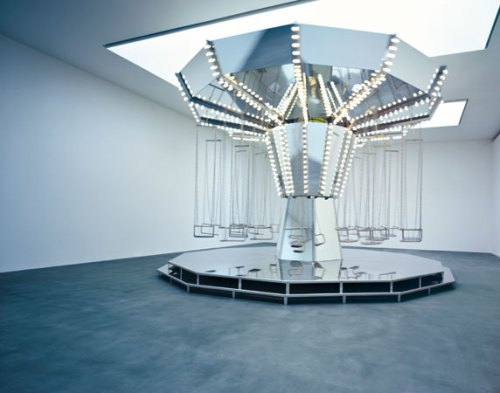A review by Lecia Bushak, REA Intern

The New Museum’s Carsten Höller exhibition, Experience, is “the first New York survey” of his works. Höller has been creating artworks for the past 20 years, after abandoning his scientific career to pursue that of an artist. The New Museum brings together a variety of Höller’s installations, sculptures, test sites, and drawings, transforming all 4 floors of the museum space into a participatory laboratory, in which viewers are encouraged to interact with the works—including a giant slide penetrating several floors, a mirrored carousel, and a sensory deprivation pool.
Höller does not intend his work to merely be viewed; rather he designs it to be experienced (hence the title of the show) and “explores the limits of human sensorial perception and logic” (New Museum). However, despite the superficially imaginative qualities of the pieces, the experience of the viewer is controlled in an almost scientific-experimental way, not leaving much room for interpretation. It seems like the viewers are lab rats in one of Höller’s larger scientific experiments, in which he interprets our actions as responses to his stimuli.
Upon entering the museum on the first floor, if wishing to participate, viewers must sign a waiver and are offered upside-down goggles, which immediately presents the exhibition as a sort of playground or funhouse with its own museum-imposed rules and regulations. Although safety is certainly an issue (the day I went, it was also children’s day, which meant the slide and other interactive pieces were swarmed with kids), it immediately renders the exhibition as a regulated, controlled, and limited so-called “experience.”


The most visually effective piece is the mirrored carousel. Silent and slow moving to the point of being imperceptible, yet illuminated and glowing, it is a bizarre counterpart to a familiar carousel. Participants sit with comatose expressions, waiting for their seats to move ever so slowly; they become part of the spectacle. It is paired with “Singing Canaries Mobile,” a structure of cages filled with chirping birds, which is hung from the ceiling and also moving slowly. The two pieces provide the viewer with a strange and potentially nauseating, but also hypnotic, visual motion.
Although the museum organized the show thematically floor by floor (i.e. the 4th floor focuses on movement, 3rd floor on utopian architectural spaces, 2nd floor on self-experimentation and confusion of senses), it is still rather disjointed. I found the architectural structures such as the carousel, the slide, and the giant psycho tank to be more connected and effective together than the 2nd floor’s assaulting flashing lights paired with the low-lying, neon-colored creature sculptures, which leave the viewer in an overall state of annoyed confusion. But perhaps that’s what the artist intended.

Strange colorful sculptures, although interesting pieces on their own, seemed out of place amidst the Dan Flavin-esque flashing lights.
Perhaps this idea of controlled experimentation on the viewers’ senses considers the way society itself controls much of our experiences. Even the way we move—through buildings, on the street, up and down stairs, is controlled by social standards and norms, architectural infrastructures and human designs—similarly, Höller and the New Museum control the way we travel down the slide. The slide then controls what turns our body makes and how fast it goes. Beyond that, the way we move and interact with things is influenced by our own vision—and perhaps by giving us upside-down goggles, flipping the world over, Höller gives us a chance to escape our own limits (albeit in a controlled way, and in the limited setting of a ‘playground’ or constructed ‘funhouse.’)
The New Museum states: “Taken as a whole, Höller’s work is an invitation to re-imagine the way in which we move through the world and the relationships we build as he asks us to reconsider what we think we know about ourselves.” For me, a true artistic experience is one that is not a cushioned playground or “testing” site, but the real thing, released into the wild. This ideal raw experience would have no rules or safety helmets to buffer our risk of panic when presented with disorder and disruptive sensations.
